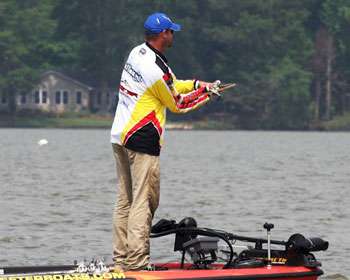
To the untrained eye, Elite Series angler Bradley Hallman might look out of place slinging a big-lipped crankbait across a shallow point in just a few feet of water. After all, a DD22 crankbait is better suited to probe the depths rather than get a sunburn on its back, right? Wrong. During early and mid summer, "crashing a crank" can pay off with some impressive limits of bass.
"Most people think that if you throw a deep diving crankbait in shallow water, it's going to get hung up, but it doesn't," says the Oklahoma pro. "That big bill gets down in the rocks and mud and kicks up dirt." With warm water temperatures giving the bass a higher metabolism, the commotion caused by a crashing crankbait often triggers an aggressive strike.
When looking for the ideal location to crash a deep diving crankbait, Hallman analyzes several factors. Ideally, Hallman will position his boat over deep water and cast to a shallow point. "I'll get on a long tapering point that drops of into the creek and river channels where the boat is sitting in 20 to 100 foot and I'm throwing the bait into 4 feet or less," he explains.
Hallman also looks for schooling baitfish on shallow points. With the bass looking to feed, baitfish become a bass magnet, and it can give away the location of feeding bass.
During the 2009 Elite Series tournament on Kentucky Lake, Hallman caught schooling bass in shallow water that were keying on baitfish. "I was going down the bank throwing a DD22, and bass started schooling in shallow water," he recounts. "I had been casting in deep water on a ledge, but they came up right on top of the ledge in 3 feet of water. I caught a 6-pounder on my first cast across the top of the ledge."
Hallman believes that the big-body profile of his crankbait coupled with the digging action of the bill bouncing off the bottom triggers the bigger bass in a school. "During early summer, the bait that the bass are typically chasing is big shad," he explains. "There really aren't that many shallow diving crankbaits that have a large profile and at times, the large profile is actually more important than crashing the bait into the bottom."When it comes to bottom composition, Hallman looks for either rock or shell, depending on the lake he is fishing. In Southern impoundments, rock is his favorite option for crashing a crankbait, and when fishing lakes like Alabama's Lake Wheeler and Guntersville, he favors shell.
"The better points and shellbeds are generally facing into the current so that's a good place to start looking." he says. "Once the bill starts mixing up the bottom, it looks like something is really wrong down there and the bass will come over and see if it's something that's injured."
When fishing around shell and rock, Hallman will upgrade his line to at least 15-pound-test monofilament. "I might be missing out by not throwing fluorocarbon, but I use monofilament because I like the stretch, the resilience and the fact that it doesn't cut as much on the rocks," he explains.
Retrieval speed is another important factor in crashing a crankbait. While low gear ratio baitcasting reels have become the preferred reel for many anglers fishing big cranks, Hallman uses a 7:1, enabling him to burn the crankbait across the bottom. "If you have watched the Elite Series over the past few years at Grand Lake, Kentucky Lake, Guntersville and other crankbait lakes, a lot of guys are throwing 7:1 ratio reels," he explains. "It's an all-day chore and it wears you out, but it gets the bites. The bottom line is that it's all about speed. Speed kills, but it catches those bass."




